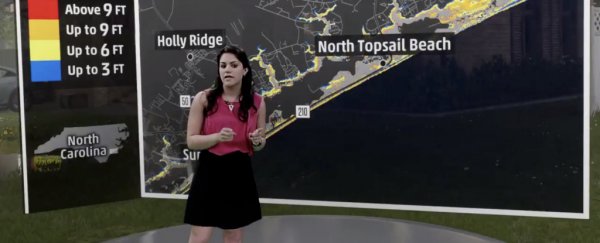Weather reports are usually the mildest parts of a TV news broadcast. But earlier today The Weather Channel put out a forecast with an unexpectedly dark twist.
It starts as a regular green screen report, with meteorologist Erika Navarro highlighting areas in North Carolina at risk from Hurricane Florence's storm surge, which could reach above 9 feet (2.7 metres) in coastal and inland riverside areas.
But then the screen behind Navarro becomes the storm surge itself, and, well, you just have to watch the whole thing.
Storm surge will be a huge factor for Hurricane #Florence Check out what it might look like with @TWCErikaNavarro: pic.twitter.com/TPqTZTmiAM
— The Weather Channel (@weatherchannel) September 13, 2018
This is an incredibly important thing for the public to be made aware of, because while hurricane reports often focus on wind speed, in the US, it's actually the storm surge of a hurricane that's most likely to kill you.
The US National Hurricane Center showed last year that between 1963 and 2012, 49 percent of US hurricane deaths were caused by the storm surge.

These storm surges can cause rapid, devastating floods shortly before or after the hurricane hits.
That might not sound as scary as winds moving hundreds of miles per hour, but it's what makes this Weather Channel demonstration so important - it shows what it would be like to suddenly become trapped in all that water.
While the green screen initially has Navarro standing on a regular city street, the simulated water starts roaring up around her shins and then waist, to show what an up to 3 foot (0.9 metre) storm surge would actually feel like if you were on the ground.
That's enough to knock you off your feet and float some cars, which is dangerous enough.
But when the storm surge gets up to 6 feet (1.8 metres), things start to get really bad. The powerful, fast-moving water quickly covers her head. Cars would be floating all around and the water could contain deadly debris such as chemicals and exposed power lines.
When things get up to the 9 foot (2.7 metre) range - which is forecast for Hurricane Florence in regions not just on the coast but also inland near rivers such as the Greenville and Simpson areas in North Carolina - it becomes a life-threatening scenario.
At this point in the forecast, roaring water is well over Navarro's head; it would be past the first floor of your home and moving incredibly fast, filled with debris and wildlife.
"If you find yourself here please get out," says Navarro. "If you're told to go, you need to go."
And while a 9-foot storm surge might sound extreme and unlikely, don't forget it's definitely not unprecedented - as this memorial at the Wrightsville Beach Museum in North Carolina shows.
Right at the top is about the 17-foot (5.2 metre) floodwater line is 1954 storm Hurricane Hazel. Hazel killed 400 people in Haiti, 95 in the US, and 81 in Canada.
Studies have already shown how much worse the flooding will be for Florence thanks to climate change, so this is not a storm to be taken lightly. Stay safe, everyone.
